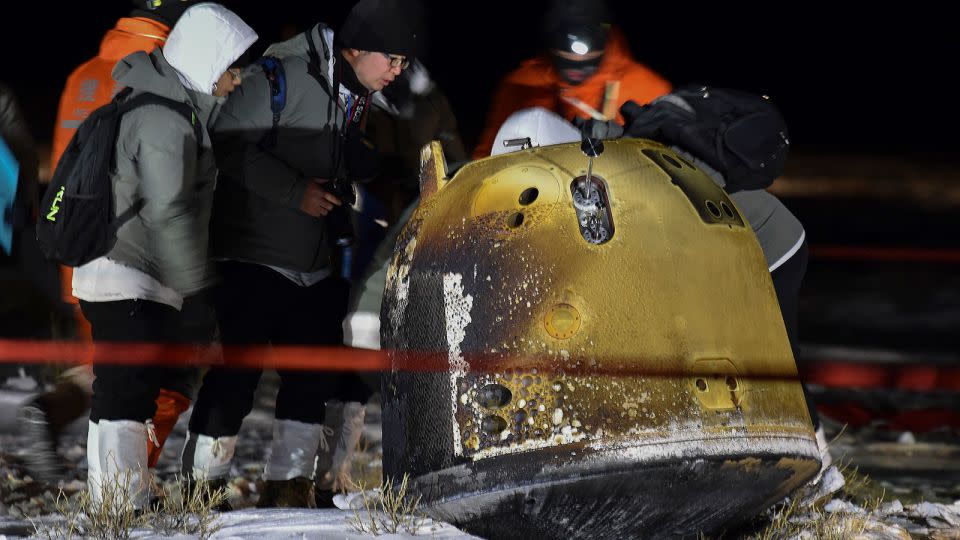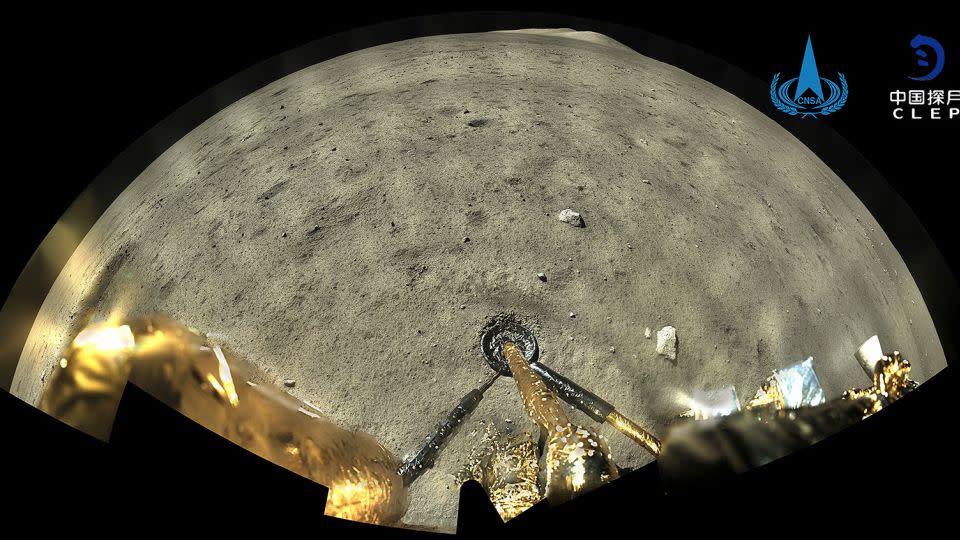Publisher’s Note: Sign up for CNN’s Meanwhile in China Newsletter exploring what you need to know about the country’s rise and its impact on the world.
When Chinese scientists analyzed soil samples brought back from the moon by their lunar probe, they discovered something groundbreaking: water was found along with minerals in the soil.
Finding water on the moon is nothing new. NASA and Indian spacecraft have found what they believe to be water on the moon’s surface, and Chinese scientists last year found water trapped in glass beads scattered across the moon.
But this latest discovery, scientists say, is the first time water has been found in its molecular form, H2O, in physical samples. Importantly, it was found in a place on the moon where water was previously thought not to exist in that form.
Researchers closely examined samples collected by China’s Chang’e-5 probe, which landed on the lunar surface in 2020, and found a “prismatic, plate-shaped transparent crystal” — about the width of a human hair — that was in fact an “unknown lunar mineral” called ULM-1, according to the study, published July 16 in the journal Nature Astronomy.
According to the research, the ULM-1 crystal (with the chemical formula (NH4)MgCl3 6H2O) is about 41% water, with bits of ammonia keeping the H2O molecules stable despite the moon’s wide temperature swings.
This type of water could be a potential “resource for lunar habitation,” the scientists wrote in their study.
The discovery is the latest finding in China’s larger push to become a dominant space power – with far-reaching ambitions that include building a research base on the moon. The study was hailed by enthusiastic Chinese social media users, who pointed to the space program as a source of national pride.
“The discovery of a hydrated mineral at the Chang’e-5 landing site is exciting and will further advance our understanding of rock-vapor reactions in the lunar crust and on the lunar surface,” said David A. Kring, a principal scientist at the Lunar and Planetary Institute in Texas, who was not involved in the study.

Difficult to extract
According to Yuqi Qian, a planetary geologist at the University of Hong Kong who was not involved in the study, there may be three types of water on the moon.
There are water molecules, the compound we know as H2O; its frozen form, ice; and a molecular compound called hydroxyl, a close chemical relative.
Previous discoveries showed that water was present on the moon when volcanoes erupted in the distant past. And that the lunar water came from those volcanoes. That is, it came from the inside of the moon and was there since the beginning of the moon’s existence.
But people didn’t always know there was water on the moon, even though scientists theorized about its existence for hundreds of years. At times, researchers thought the moon was dry, especially after they initially found no water in samples collected by NASA’s Apollo missions and the Soviet Union’s Luna missions.
Only in more recent years have scientists discovered water, ice, and water molecules that are concentrated primarily at the dark, cold lunar poles, where the sun does not reach. A recent study has also suggested that water, or hydroxyl, may be trapped in glass beads scattered across the lunar surface, and that solar winds can transform hydroxyl (chemical formula OH) into water, or H2O.
But the lunar poles are difficult to navigate because of the rocky terrain, making them tricky locations for humans to harvest water. And molecular water is “not stable in other parts of the moon” and evaporates at lower latitudes where temperatures can exceed 100 degrees Celsius (212 Fahrenheit), Qian said.
This new study changes that.
The samples, retrieved by China’s Chang’e-5 probe, came from a mid-latitude region of the moon, at 43.1 degrees latitude — a region that is normally “not stable for molecular water,” Qian said. Ammonium was found in the samples, which acted as a stabilizer for the water molecules, he explained.
This mechanism also confirms NASA’s findings from 2020, when the SOFIA telescope detected the presence of water on the lunar surface. However, scientists at the time were unable to verify this finding with physical samples, or explain exactly how the water remained on the hot surface.
“I think it has a lot of potential, this new discovery that we can extract molecular water directly from lunar soil,” Qian said. “I think this is a new mechanism to make molecular water stable on the lunar surface.”
Kring, of the Lunar and Planetary Institute, noted that although the sample was collected in a mid-latitude area, “it was not clear whether it formed there. Impact processes can redistribute rock across the lunar surface.”


China’s Space Ambitions
More and more countries, including the United States, are interested in the strategic and scientific benefits of extensive lunar exploration.
China has made rapid progress in recent years, reflecting leader Xi Jinping’s “eternal dream” of building the country into a space power.
In 2013, China became the first country in nearly four decades to land a robotic moon landing. In 2019, it became the first and only country to land on the far side of the moon. Three years later, China completed its newest space station, Tiangong.
And there are more plans: the company wants to land astronauts on the moon before 2030 and build a research base at the South Pole.
Experts previously told CNN that understanding how water is stored on the moon is useful, as it could point future astronauts to potential sources that could be converted into drinking water or even rocket fuel in the future.
Following the latest research, many Weibo users raised the possibility of growing plants or crops on the moon using the molecular water found in the soil. But, Qian said, it’s too early to draw such conclusions. Growing something on the moon would depend on factors such as how abundant the water is — which will require more research to confirm.
However, he added: “This new phenomenon, this new mechanism… will open the door to (finding) new water in this new form.”
Kring also cautioned that the findings so far “do not have significant implications for the architecture of exploration missions, although it shows that discoveries await those willing and able to explore the Moon.”
China’s rapid advances have caught the attention of NASA. The space agency has been barred from working with its Chinese counterparts since 2011, when Congress passed the Wolf Amendment, citing concerns about spying.
But last August, China gave the international community access to the Chang’e-5 samples.
“We’re going through the process now with our scientists and our lawyers to make sure that the instructions and the guardrails that the Chinese are pushing for … are not a violation of the law, the Wolf Amendment,” NASA Administrator Bill Nelson recently told CNN. “At this point, I don’t see a violation.”
But such problems have led to China being banned from the International Space Station (ISS), fueling China’s efforts to build the Tiangong, which has become a challenger to the US, especially as the ISS prepares to retire in 2031.
These restrictions on international space cooperation, and the rise of China itself, have led some Chinese social media users to feel vindicated by the latest discovery. Online commentary and state media coverage have praised the progress of the nation’s space program.
“This is a demonstration of our country’s scientific and technological strength!” posted one user on Chinese social media site Weibo, where a hashtag about the discovery has been viewed 35 million times.
Another user thanked the country’s space program, writing, “We are at the forefront of global scientific research on the moon.”
Others on Weibo urged more cooperation for the benefit of humanity, pointing out that the study was published in an international journal and reviewed by experts from several countries.
“We can’t work behind closed doors – best thing would be to bring all their scientists to China,” one wrote.
For more CNN news and newsletters, create an account at CNN.com